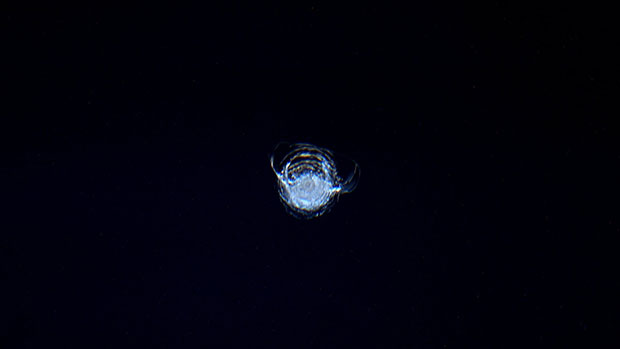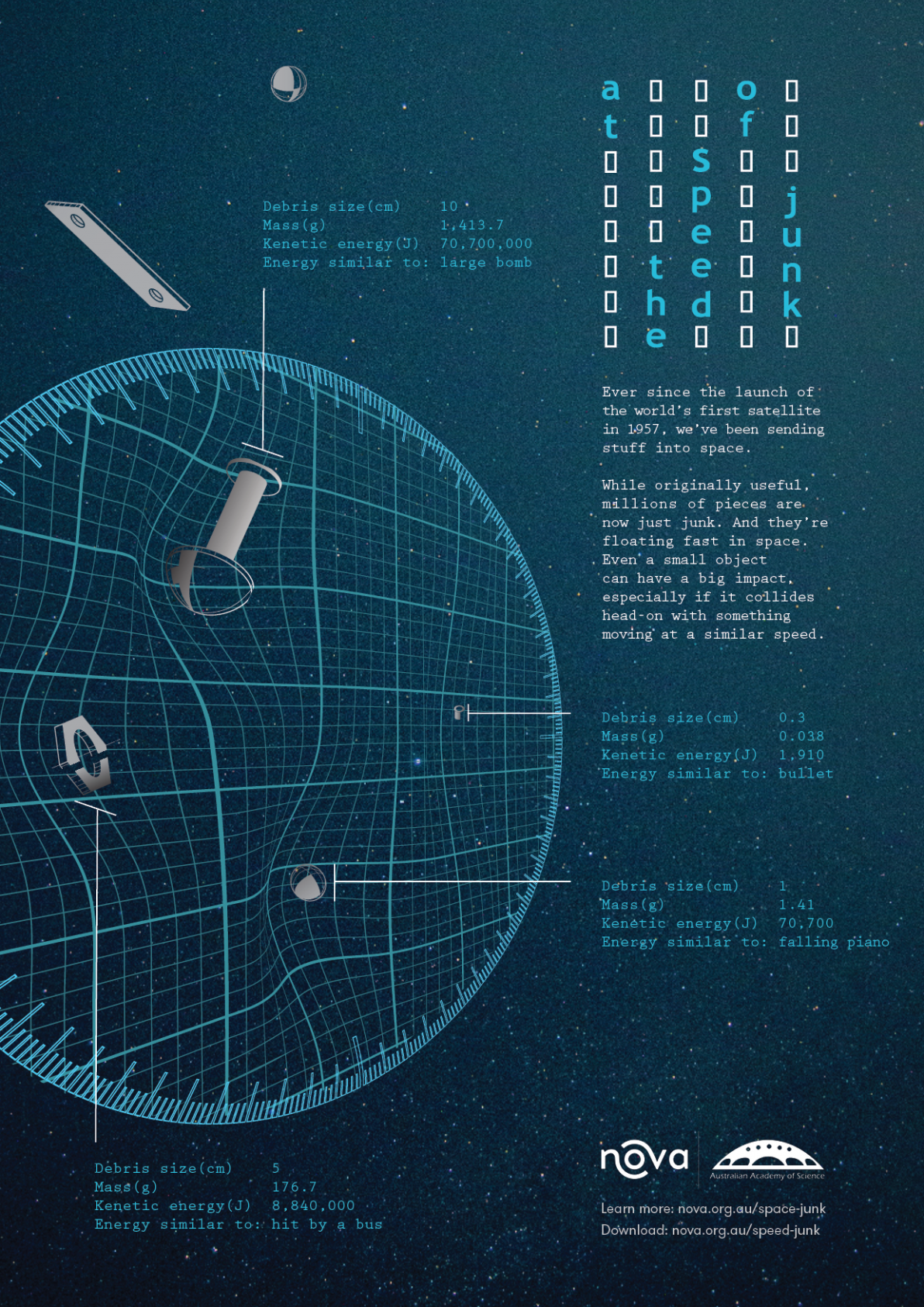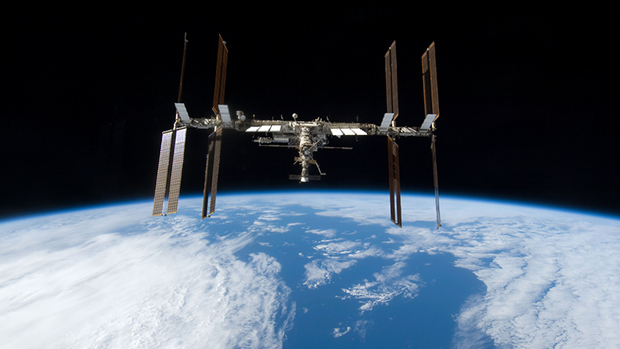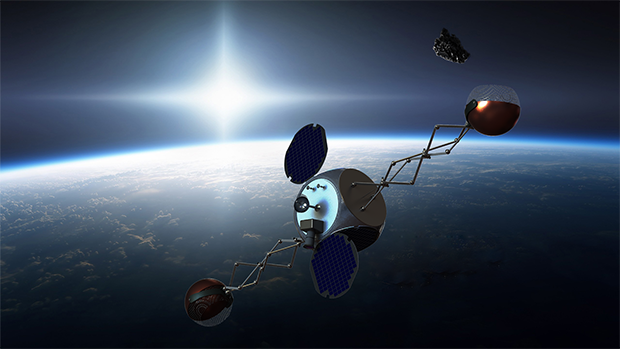Tackling space junk
Expert reviewers
Essentials
- Space junk poses a threat to spacecraft, especially essential satellites.
- There are estimated to be millions of pieces of man-made debris in space, from paint flakes to defunct satellites.
- Collisions and explosions are major contributors to the proliferation of space junk.
- Debris hitting other pieces of debris could result in a cascading accumulation of junk in space, with potentially disastrous consequences.
Ever since the launch of the world’s first satellite in 1957, Sputnik 1, we’ve been sending stuff into space.
Exactly how many pieces of space junk, also known as orbital debris, are out there is hard to know—but estimates are that it’s in the millions.
And it’s not just astronauts who should be worried. From telecommunications to defence, our modern lives rely for just about everything on the thousands of satellites orbiting Earth. The potential for space junk to collide with and damage satellites makes orbital debris not just an interesting curiosity but an urgent problem in need of solutions.
How urgent, exactly? How long until there’s so much junk in space that we’re no longer able to use it? Some estimates give us as little as 20 years. But exact predictions are hard to make: while a large collision could provide the tipping point, if we’re lucky this mightn’t happen for a long time. What is certain is that if we take no action at all, then inevitably space will—sooner or later—become unusable.
Like a nuclear reaction
Old rockets and defunct satellites are not the only man-made objects cluttering up space. Orbital debris includes all sorts of objects from spent rocket stages and satellites abandoned at the end of their useful life to bolts, lens caps, bits of insulation and fragments of paint. While at present not all small bits of debris can be tracked, extensive population sampling and space surveys indicate that there are more than 300,000 pieces of man-made junk greater than 1 centimetre in size, with the greatest density of junk in low Earth orbits.
Why so much junk? Wear and tear is one culprit. Solar radiation and heating can degrade materials in space, producing debris such as paint flakes—which may not seem like such a big problem until you realise that one tiny paint flake in orbit can be enough to crack a window of the International Space Station.

Explosions are an even bigger issue, with the potential to turn one large piece of junk into several thousand fast-moving missiles. Unused fuel in abandoned satellites can cause them to blow up, as can the overheating of old batteries. Explosions aren’t always accidental: in 2007, China tested an anti-satellite missile by shooting it at one of its old satellites, adding as much debris to the space junkyard as over the previous 50 years.
Then there are collisions between satellites, such as that between a defunct Cosmos satellite and an active Iridium satellite in 2009 which created over 2,000 pieces of debris. When it comes to the ever-growing proliferation of space junk, it’s not just debris colliding with active satellites, or even the International Space Station, that’s the only problem. It’s also debris colliding with itself. While you might expect all these pieces of junk to be travelling in orbit in the same direction—creating clutter but not too much potential for collision—in fact this isn’t the case. Natural gravitational forces change the orbits of debris over time, resulting in bits of junk moving in different directions. The effect is like a runaway nuclear reaction, where neutrons hit nuclei, spawning more neutrons, which hit more nuclei, and so on, leading to a nuclear bomb. Junk collides with other junk, making more fragments, which then collide with other pieces of junk creating … well, you get the picture. Known as the Kessler syndrome (after NASA scientist Donald J Kessler who proposed it in the 1970s), it’s a scenario in which space debris collisions cause a domino effect, potentially resulting in an overwhelming amount of debris. Left to its own devices, a catastrophic avalanche of collisions could quickly destroy all orbiting satellites in low Earth orbit and make the launching of new ones impossible.

A $2 trillion problem
As rocket scientist Natalie Panek points out, our lives depend on a world we can’t see. Though we might not often stop to think about these objects twirling through space, we rely on satellites to get by—whether it’s making a call on our mobile, finding our way to a restaurant or working out whether we need to slap on a hat or pack an umbrella. Beyond our personal lives, the more than 3,000 active satellites currently in orbit are essential for everything from observing the effects of climate change to monitoring for defence purposes. The satellites in orbit at any given time are worth about A$700 billion, and generate about A$2 trillion in business every year—damage to them could have disastrous consequences, for our economies and our lives.
Paint damage
Orbital debris travels fast, meaning that even relatively small objects can have a big impact, especially if they hit something moving at similar speeds in another direction. Imagine a 5 millimetre-sized piece of metal in low Earth orbit, which would typically travel at about 10 kilometres a second (36,000 kilometres an hour). Now imagine you were also in space, and also moving that fast. If the debris were coming towards you from the other direction, its relative speed would be twice as fast: 20 kilometres a second (72,000 kilometres an hour). If you were to collide, the piece of debris would go straight through you.
So what does this mean for the International Space Station and other spacecraft? It depends on the size of the junk and where it hits. Pieces of debris less than a millimetre in size won’t usually have an impact on a spacecraft’s ability to function, although they can erode sensitive surfaces such as optics and solar arrays. Debris between a millimetre and a centimetre in size may or may not penetrate a spacecraft, depending on what materials are used and whether the spacecraft has shielding. A piece of junk this size could have a disastrous effect if it penetrates a critical component such as the flight computer. Debris between 1 and 10 centimetres in size will penetrate and damage most spacecraft—and can also create a significant number of small pieces of debris. Catastrophic damage can be caused by debris 10 centimetres or larger.

The International Space Station has limited protection against debris. Its Whipple (two-layered) shields can protect it from particles up to about 3 millimetres (that’s just slightly thicker than the width of an Australian two-dollar coin) in size. But adding protection from larger objects is impractical—it would simply make the space station too heavy. For debris bigger than that, the only option is to manoeuvre the station out of the way. Where there’s a risk to the crew, auxiliary Soyuz spacecraft, used to transport people to and from the station, can be used as a ‘lifeboat’ for crew members.
Moving targets
Tackling the space junk problem isn’t as simple as doing the rounds with a galactic garbage truck. Just figuring out where the pieces of debris actually are can be a major headache. Not only are they often tiny and hundreds, if not thousands, of kilometres away, but they’re in motion, meaning that any ‘map’ of space junk needs to be constantly updated. And the movements of space junk are unpredictable, with gravitational anomalies, Earth’s magnetic field and other factors—notably collisions with other bits of space junk—affecting their trajectories.
Australian scientists have developed new laser tracking technology to determine the orbits of more space debris more accurately than has previously been possible. More tracked debris means more avoidable collisions. Accuracy is important, because satellites don't carry enough fuel to be able to manoeuvre large distances around uncertain debris positions. Comprehensive debris avoidance strategies are now possible for many satellites, and this protection is expanding.
The next step is to use the accurate debris orbits to move debris around satellites, rather than move satellites around the debris.
What can be done?
The first step, already well under way, is knowing what debris is out there and what dangers it might pose. Across the globe, all spacefaring nations cooperate to share debris data and orbits for the largest 20,000 debris objects (exceeding 20 centimetres in size)—in other words, debris that’s big enough to create a lot of new debris if it collides with a satellite or with other debris. Thanks to Australian tracking, accurate debris orbits can be provided which allow satellites to manoeuver out of the way. While it’s a good start, this is only 10 per cent of known, dangerous debris. In Australia, the Space Environment Research Centre, (SERC) is researching ways to increase the power of Australia’s laser trackers so that lasers on Earth can move space debris.
The most effective solution to the space junk problem will most likely be a multifaceted one—a combination of preventing the creation of new debris; minimising collisions; de-orbiting small debris; and removing large objects.
Keeping it clean
There are already international protocols for preventing more space debris from being created. A major part of this is making sure that ageing satellites are removed from orbit. International guidelines specify that new satellites must be made to deorbit (exit orbit and begin descent) within 25 years of the end of their life. Because objects in higher altitudes can’t be brought back to Earth within this time period, the recommendation is that they be placed in ‘graveyard’ orbits beyond the highest active satellites. Although neither of these guidelines are binding under international law, international monitoring over two decades showed a very significant decrease in growth of debris—until, that is, the Chinese anti-satellite test and the accidental collision of those two large satellites caused a surge in debris to levels where debris-on-debris collisions will now cause more growth. After decades of global discipline, the debris genie is again out of the bottle.
Stopping satellites from exploding by venting or burning up leftover fuel, or designing batteries that are less likely to blow up, is also important. Preventative design—incorporating things like tethered lens caps or bolt catchers for explosive bolts—could also help stop bits of spacecraft becoming bits of space junk. One proposal is for satellites to be equipped with large, very light sails, which will create enough atmospheric drag for them to be deorbited more quickly.
Getting out of the way
Simple as it sounds, minimising collisions by moving a satellite out of the path of a piece of dangerous space debris can be complicated. A major challenge is to track the position of dangerous objects with enough certainty to be able to move a satellite out of their way. At the moment, this can be predicted for most objects to within 5 to 10 kilometres, but this needs to be closer to less than 200 metres. Then there’s the matter of moving a satellite in time: because the trajectory of a satellite coasting in an orbit adheres to the laws of physics, it can be difficult to alter its orbit with little warning. Finally, there's the problem that ‘dead’ satellites and space debris cannot be manoeuvred, so their collisions cannot be avoided.
Decluttering the skies
Simulations show that, thanks to explosions and collisions between existing debris, even if we were to introduce no new objects into space the number of pieces of space junk will keep growing exponentially. That makes not just preventing space junk, but proactively removing it, especially the larger pieces, a necessity if we’re to keep using space.
Again, this may be easier said than done. Physically capturing debris with robot arms and manoeuvring it with a space tug is one option—although it can actually be very hard to grab objects that may be rapidly spinning or tumbling through space and, in the case of old spacecraft, can be extremely heavy. And it has to be done carefully, as there’s always the possibility that they could break up or explode, further adding to the number of pieces of out-of-control debris. This approach is also extremely expensive.

What about zapping them with lasers? Australian and international scientists at SERC been working on lasers and beam propagation systems which, operated from the ground, could be used to tackle space debris—not by obliterating it but, a bit like a space ‘broom’, by nudging it into low Earth orbits for re-entry using radiation pressure. The first trials of this technology will be performed in 2019.
The big clean-up: who’s responsible?
Legally, the country who put a satellite into space remains its owner—even if it’s no longer in use or has broken up into hundreds, or thousands, of pieces. So, while cleaning up someone else’s mess might seem like the height of altruism, one country can’t get rid of another country’s junk without their permission. Scientists in Australia and beyond continue to work towards technological solutions to the orbital debris problem. But space law and international cooperation in tackling space junk, from mitigation to clean-up, will need to keep step.





